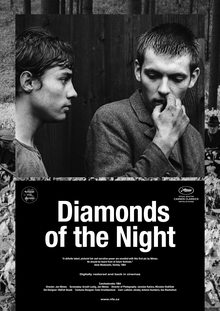Diamonds of the Night
Diamonds of the Night (Czech: Démanty noci) is a 1964 Czech film about two boys on the run from a train taking them to a concentration camp, based loosely on Arnošt Lustig's autobiographical novel Darkness Has No Shadow.[1] It was director Jan Němec's first full-length feature film.
| Diamonds of the Night | |
|---|---|
 Film poster | |
| Directed by | Jan Němec |
| Produced by | Jan Procházka Erich Svabík |
| Written by | Arnošt Lustig Jan Němec |
| Starring | Ladislav Jánský Antonín Kumbera |
| Music by | Vlastimil Hála Jan Rychlík |
| Cinematography | Jaroslav Kučera Miroslav Ondříček |
| Edited by | Miroslav Hájek |
Release date |
|
Running time | 63 minutes |
| Country | Czechoslovakia |
| Language | Czech |
Production
Němec was influenced by the early films of Luis Buñuel and Robert Bresson's A Man Escaped and novels of William Faulkner.[2] Němec cast a Roma railway worker Antonín Kumbera after seeing him in a documentary Železničáři by Evald Schorm. The other lead Ladislav Jánský was a photographer and occasional actor. In the middle of shooting cinematographer Jaroslav Kučera was invited to the film festival in South America and left. The rest of the movies was finished by Miroslav Ondříček. The opening tracking shot was the longest in the Czechoslovak cinema's history. It cost a third of the film's budget.
Plot
Diamonds of the Night begins with two teenage boys fleeing from a train and shedding, as they run, long black coats, on the backs of which are painted in white the letters "KL," the abbreviation for Konzentrationslager (concentration camp). Behind them are the sounds of shouting and shooting. The film employs little dialogue, and the boys' escape through forests and swamps and across rocky terrain is interpolated with the dreams, memories, hallucinations, fantasies, and flashbacks of the younger of the two boys. In one sequence, the younger boy recalls exchanging his shoes with the older boy for a piece of food; in another, he seems to imagine returning to the apartment in Prague where he used to live; and in a third, he rides a Prague tram with shot-out windows while wearing once again the coat that identifies him as a concentration camp escapee.
When the boys encounter a farmer's wife, the younger boy follows her into her kitchen to ask for food, and as he struggles with thoughts of murder and rape, the film repeatedly shows both possibilities. In the end, the boy silently takes a few slices of bread from her and leaves. Eventually, the boys are caught by a shooting party of elderly German-speaking men, who detain the boys in a beer hall while they drink, eat, sing, and dance, before turning the boys over to the mayor. As the boys are marched out, the leader of the shooting party calls out, "Ready, aim, fire," but the men merely laugh. The ending is ambiguous: either the boys have been spared, or they are walking to their execution.
Cast
- Ladislav Jánský as the First Boy
- Antonín Kumbera as the Second Boy
- Vladimír Pucholt as the Second Boy (voice)
- Ilse Bischofová as the woman
Reception
Diamonds of the Night holds an 90% approval rating on Rotten Tomatoes,[3] with Eric Hynes of Time Out writing, "Němec’s technique is as emotionally intuitive as it is masterful, purposefully scrambling past and present, handheld realism (a breathless opening tracking shot) and Buñuellian surrealism (fever-dreamed ants colonizing Jánský’s angelic face). It’s a torrent of life—and cinema—in the face of death."[4]
Awards
- Grand Prize for Best Debut film at 1964 International Filmfestival Mannheim-Heidelberg
- Best Editing of the Year 1965 in Films and Filming magazine.
References
- Hames, Peter (May 14, 2001). "Jan Nemec: Enfant terrible of the New Wave". www.ce-review.org. Central Europe Review. Archived from the original on June 9, 2012. Retrieved September 11, 2018.
- "Faceted Depictions of War: On Jan Němec's 'Diamonds of the Night'". Pop Matters.
- Diamonds of the Night (Démanty noci), retrieved 2018-07-22
- "Diamonds of the Night: movie review". Time Out New York. Retrieved 2018-07-22.
External links
- Diamonds of the Night at AllMovie
- Diamonds of the Night on IMDb
- Diamonds of the Night: Into the Woods an essay by Michael Atkinson at the Criterion Collection